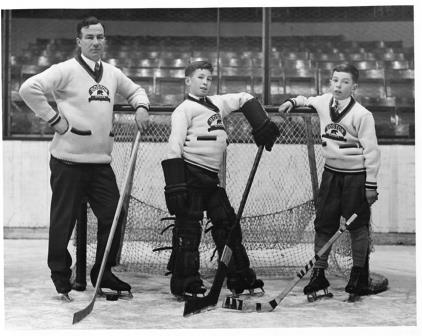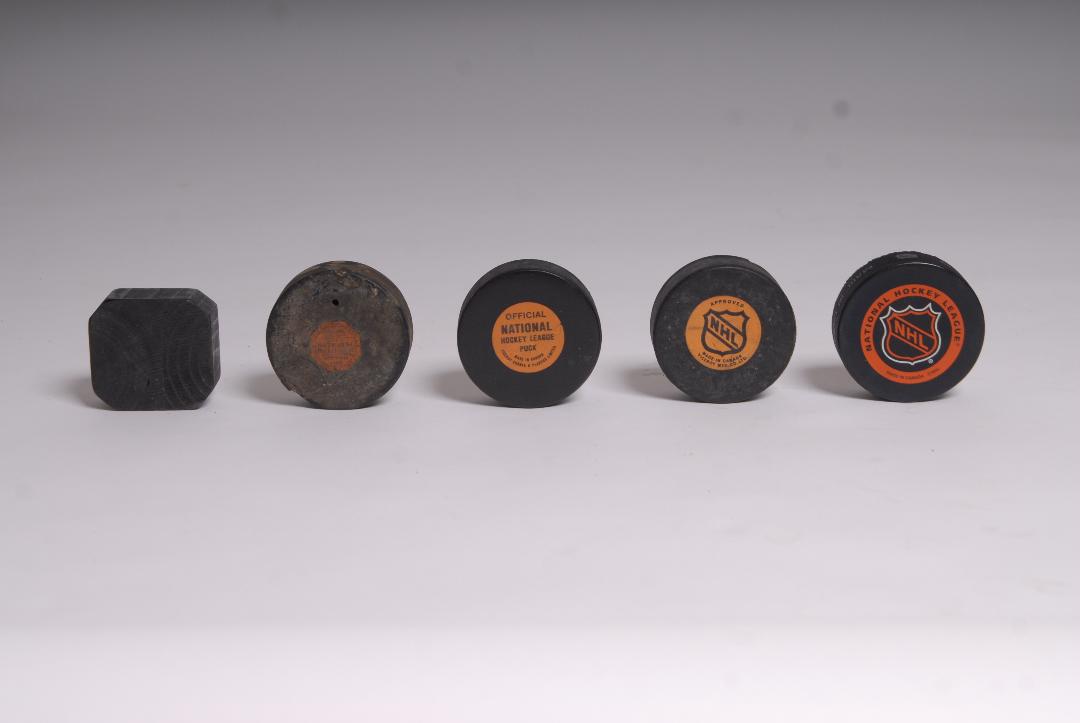The history of the puck: Fiery comets, bouncing balls and wooden pucks
%20jpg.jpg) Prior to the first organized hockey game in Kingston, someone took a rubber lacrosse ball, cut out a slice and trimmed the edges to form a square puck. Lennox Irving of Queen’s would score the only goal with it as the university team defeated the Royal Military College cadets 1-0 on March 10, 1886 on the Lake Ontario harbour ice.
Prior to the first organized hockey game in Kingston, someone took a rubber lacrosse ball, cut out a slice and trimmed the edges to form a square puck. Lennox Irving of Queen’s would score the only goal with it as the university team defeated the Royal Military College cadets 1-0 on March 10, 1886 on the Lake Ontario harbour ice.
Today, that puck remains one of the most important artifacts at the Original Hockey Hall of Fame. While it looks like a lump of coal, it is in fact one of the oldest pucks still in existence. The history of the game includes shinny played with frozen cow patties, pucks made out of wood so that fans would not be injured by flying balls and, in the modern era, pucks that would emit a fiery tail on television when shot at lightning speed.
“The square puck has great significance to Kingston’s storied hockey history and we are proud to have it in our collection to share with hockey fans,” says Mark Potter, past president of the Hall. “It’s a great reminder of how the game has evolved and grown and the important role Kingston played in its development.”
“The puck does not resemble the pucks that are used today,” notes Larry Paquette, president of the Kingston Hall. “But it’s pretty cool to think that we have an item from 1886 from a game played between Queen’s and RMC – still the world’s oldest hockey rivalry.”
Long before the implementation of protective glass and netting, hockey organizers had fan safety in mind. This led to one of the most important changes in the game. In the mid 1800s, hockey usually featured rubber lacrosse balls, not pucks. However, balls were hard to control and bounced wildly on the ice. When the managers of the first structured hockey game in Montreal in 1875 were planning the event, they wanted to have paying fans enjoy the show. They quickly realized that a flying lacrosse ball could seriously injure a spectator.
The Montreal crew came up with a different idea: A square puck made out of wood. Reported the Montreal Gazette on March 4, 1875: “Hockey is played usually with a ball, but last night, in order that no accident should happen, a flat block of wood was used, so that it should slide along the ice without rising, and thus going among the spectators to their discomfort.”
“Discomfort” is a mild term for being struck by a hard rubber ball fired by a hockey player. At any rate, the idea of using a puck held favour and they were usually made of wood or rubber.
By the early 1900s, the puck was rounded, not square, looking similar to a modern-day puck. It was easier to stick handle and shoot with a round puck. The pucks were made of layers of rubber that were glued together. By the 1940s, pucks were manufactured from synthetic rubber, rather than the natural substance.
 Today, Art Ross (in photo on left with his sons) is known for the trophy in his name given to the NHL scoring leader each year. In his day, the Boston Bruins general manager and coach was an innovator. He invented a new net that prevented pucks from bouncing out, reducing the number of disputed goals. In 1918, he introduced a puck with beveled edges that stopped the puck from bouncing. He patented the Art Ross puck in 1940 and it was used exclusively as the official NHL puck from 1942 to 1968.
Today, Art Ross (in photo on left with his sons) is known for the trophy in his name given to the NHL scoring leader each year. In his day, the Boston Bruins general manager and coach was an innovator. He invented a new net that prevented pucks from bouncing out, reducing the number of disputed goals. In 1918, he introduced a puck with beveled edges that stopped the puck from bouncing. He patented the Art Ross puck in 1940 and it was used exclusively as the official NHL puck from 1942 to 1968.
The concept of using new pucks for every game was a long way off. When Gordie Howe became the first player in history to notch 700 NHL goals on Dec. 4, 1968 in a 7-2 win over Pittsburgh, the history-making puck had a badly worn Penguins logo. To mark the occasion, a silver band was added around the puck.
It was only in 1995 that technology was introduced into pucks. While it looked exactly like a regular puck on the outside, the FoxTrax “comet puck” had a chip and battery inside. It had 20 pin holes that guided infrared emitters, each beeping 30 pulses per minute. These sent messages to 16 sensor devices placed around the rink to follow the puck’s movement. The result? Fans watching on TV would see the puck light up with a red comet-like tail if the puck was shot at speeds of 50 mph. If the shot hit 75 mph, the tail turned green.
Fox Sports, which had just won the rights to broadcast the game in the United States, wanted a puck that would be easier for fledgling fans to follow.
“If you talk to die-hard fans, they didn’t like it,” says Phil Pritchard of the Hockey Hall of Fame in Toronto. While Pritchard is best known as the Keeper of the Stanley Cup, he has been researching the history of the puck. “To me, the FoxTrax puck was a great help in educating the public and bringing new fans to the game.”
“However, some players told me that they felt it wasn’t like a true puck because it didn’t slide on the ice properly,” Pritchard says.
The glowing puck faced another huge problem: cost. Every time one of them was shot into the crowd it was an estimated $400 down the drain.
Fox only held the US television contract for a few years; once it lost it, the FoxTrax puck was dropped. By then, Americans had caught on to the game and were able to follow the regular puck on TV.
As most fans know, pucks are frozen prior to each game so that they don’t bounce during play. However, it’s difficult for officials to know if a puck has thawed too much to remain in use. The PPG Paint company, the official paint of the NHL, came up with a special paint that changes colour when it gets warm – indicating to the on-ice officials to bring out a new puck. This innovation is still in the testing phase.
Today, the NHL has brought back a system similar to FoxTrax. While the puck doesn’t light up on television, it creates a treasure trove of data. At each arena, more than a dozen infrared cameras track sensors in pucks and player jerseys. This generates information on player ice time, shot location and more. Coaches can use the data in real-time and TV analysts can crunch the numbers for a team or individual player.
“Maybe the FoxTrax puck was ahead of it’s time,” says Pritchard. “Technology is helping to change the game and move it forward.”
What’s next for the small chunk of rubber? The league could develop a puck that changes colour or glows when it crosses the goal line. This would make it easier for both referees and fans to know when a goal has been scored.
It’s a long way from the Kingston harbour when someone sliced open a lacrosse ball and players battled to shoot it between two wooden posts frozen in the ice.